Dose-dependent modulation of CD8 and functional avidity as a result of peptide encounter
- PMID: 17484768
- PMCID: PMC2266002
- DOI: 10.1111/j.1365-2567.2007.02622.x
Dose-dependent modulation of CD8 and functional avidity as a result of peptide encounter
Abstract
The generation of an optimal CD8(+) cytotoxic T lymphocyte (CTL) response is critical for the clearance of many intracellular pathogens. Previous studies suggest that one contributor to an optimal immune response is the presence of CD8(+) cells exhibiting high functional avidity. In this regard, CD8 expression has been shown to contribute to peptide sensitivity. Here, we investigated the ability of naive splenocytes to modulate CD8 expression according to the concentration of stimulatory peptide antigen. Our results showed that the level of CD8 expressed was inversely correlated with the amount of peptide used for the primary stimulation, with higher concentrations of antigen resulting in lower expression of both CD8alpha and CD8beta. Importantly the ensuing CD8(low) and CD8(high) CTL populations were not the result of the selective outgrowth of naive CD8(+) T-cell subpopulations expressing distinct levels of CD8. Subsequent encounter with peptide antigen resulted in continued modulation of both the absolute level and the isoform of CD8 expressed and in the functional avidity of the responding cells. We propose that CD8 cell surface expression is not a static property, but can be modulated to 'fine tune' the sensitivity of responding CTL to a defined concentration of antigen.
Figures

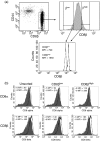
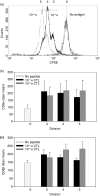
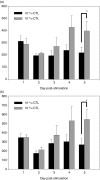
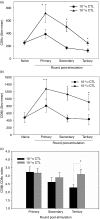
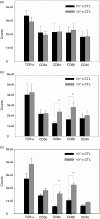
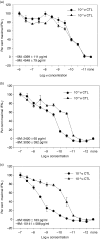
Similar articles
-
Changes to peptide structure, not concentration, contribute to expansion of the lowest avidity cytotoxic T lymphocytes.J Leukoc Biol. 2004 Oct;76(4):787-95. doi: 10.1189/jlb.0104026. Epub 2004 Jul 7. J Leukoc Biol. 2004. PMID: 15240746
-
Role of antigen, CD8, and cytotoxic T lymphocyte (CTL) avidity in high dose antigen induction of apoptosis of effector CTL.J Exp Med. 1996 Aug 1;184(2):485-92. doi: 10.1084/jem.184.2.485. J Exp Med. 1996. PMID: 8760802 Free PMC article.
-
Specific epitope-induced conversion of CD8+ memory cells into effector cytotoxic T lymphocytes in vitro: presentation of peptide antigen by CD8+ T cells.Eur J Immunol. 1992 Jun;22(6):1595-601. doi: 10.1002/eji.1830220637. Eur J Immunol. 1992. PMID: 1376266
-
CD11b (Mac-1): a marker for CD8+ cytotoxic T cell activation and memory in virus infection.J Immunol. 1992 Aug 15;149(4):1326-33. J Immunol. 1992. PMID: 1500720
-
Low binding capacity of murine tetramers mutated at residue 227 does not preclude the ability to efficiently activate CD8+ T lymphocytes.Immunol Lett. 2005 May 15;98(2):208-15. doi: 10.1016/j.imlet.2004.11.016. Epub 2004 Dec 10. Immunol Lett. 2005. PMID: 15860220
Cited by
-
High avidity cytotoxic T lymphocytes can be selected into the memory pool but they are exquisitely sensitive to functional impairment.PLoS One. 2012;7(7):e41112. doi: 10.1371/journal.pone.0041112. Epub 2012 Jul 19. PLoS One. 2012. PMID: 22829916 Free PMC article.
-
In vivo modulation of avidity in highly sensitive CD8(+) effector T cells following viral infection.Viral Immunol. 2013 Oct;26(5):302-13. doi: 10.1089/vim.2013.0042. Epub 2013 Aug 24. Viral Immunol. 2013. PMID: 23971914 Free PMC article.
-
Tricks with tetramers: how to get the most from multimeric peptide-MHC.Immunology. 2009 Feb;126(2):147-64. doi: 10.1111/j.1365-2567.2008.02848.x. Immunology. 2009. PMID: 19125886 Free PMC article. Review.
-
Comparative Immunogenicity in Rabbits of the Polypeptides Encoded by the 5' Terminus of Hepatitis C Virus RNA.J Immunol Res. 2015;2015:762426. doi: 10.1155/2015/762426. Epub 2015 Nov 2. J Immunol Res. 2015. PMID: 26609538 Free PMC article.
-
miR-155 Overexpression in OT-1 CD8+ T Cells Improves Anti-Tumor Activity against Low-Affinity Tumor Antigen.Mol Ther Oncolytics. 2019 Dec 25;16:111-123. doi: 10.1016/j.omto.2019.12.008. eCollection 2020 Mar 27. Mol Ther Oncolytics. 2019. PMID: 32021906 Free PMC article.
References
-
- Yee C, Savage PA, Lee PP, et al. Isolation of high avidity melanoma-reactive CTL from heterogeneous populations using peptide-MHC tetramers. J Immunol. 1999;162:2227–34. - PubMed
-
- Zeh HJ, III, Perry-Lalley D, Dudley ME, et al. High avidity CTLs for two self-antigens demonstrate superior in vitro and in vivo antitumor efficacy. J Immunol. 1999;162:989–94. - PubMed
Publication types
MeSH terms
Substances
Grants and funding
LinkOut - more resources
Full Text Sources
Other Literature Sources
Research Materials

